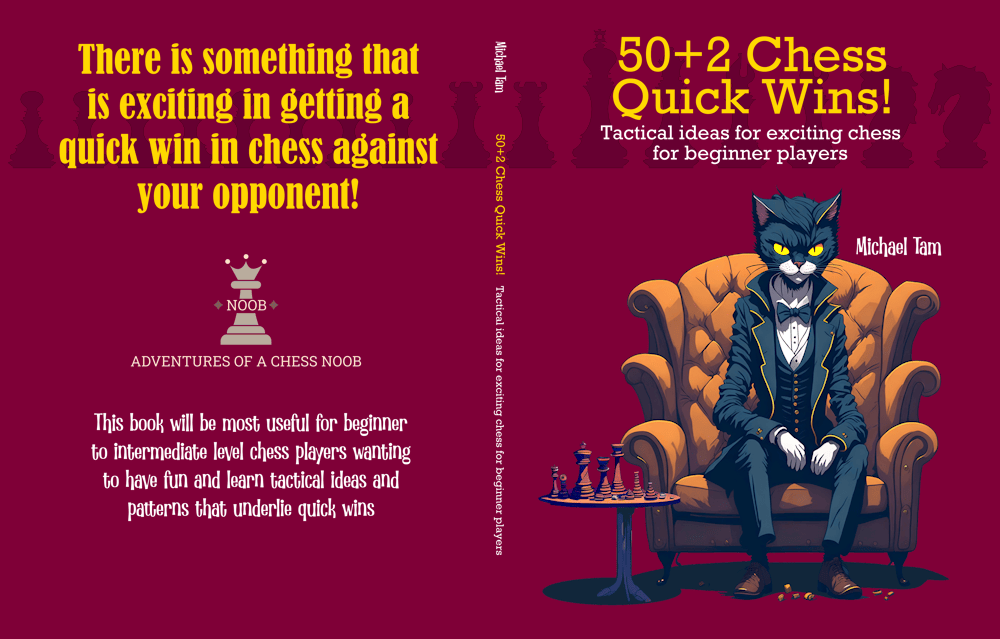
2 Games, 2 Gambits | GLORIOUS VICTORY! ✌️
#tournament #gambits #ponzianisteinitzgambit #viennagambit #hamppeallgaiergambit
Those of you who follow my blog series and channel will know that I love chess quick wins! Indeed, I've written a book on the topic - don't miss out on your copy! - and my Chess Noob Quick Wins series is at the time this was written, up to number 68! Although there is undoubtedly pleasure in winning (who doesn't like to win?), it is the trickiness of many of these lines, the beautiful romanticism of this style, that I find so attractive.
One of the best expressions of romantic chess are opening gambits, especially the unsound ones! These are two games with a very friendly Greek gentleman, a fellow contestant in my group in round 1 of the 2024 Chess.com Daily Chess Championship. Two games, two gambits, and happily for me, two wins. But not just any win! Sure, at a pragmatic level, a win could be reduced to simply a "point" in the tournament scoring. However, there is something magical in winning with a creative and unexpected line that makes you smile. GLORIOUS VICTORY!

![]()
Game 1 - Italian Game, Two Knights Defense, Ponziani-Steinitz Gambit
I play Black in this match, and it starts in the most unassuming way. White plays the Italian Game, and I respond with the Two Knights Defense (1. e4 e5 2. Nf3 Nc6 3. Bc4 3. Nf6) - all very normal. White then decides to play aggressive with the immediate Knight Attack (4. Ng5) which is potentially the beginning of the Fried Liver Attack, something that can strike terror in the hearts of beginner players! And it's actually in practice; in a large online database of community games of blitz and rapid of lower-rated players, the Knight Attack has a win advantage (White 54% vs Black 42%) in over seventeen million games from that position! Indeed, many beginners choose to not play the Two Knights Defense altogether, to avoid having to face the Fried Liver!
However, against the Knight Attack, we the audacious, unsound, and beautiful Ponziani-Steinitz Gambit (4... Nxe4). The chess.com analytic engine rates this a mistake, and with a Stockfish 16 NNUE evaluation of [+2.7] at high depth favouring White, this seems to be the case. White has their knight and bishop both staring at Black's weak f-pawn on f7 - this move doesn't defend against that. And even if we don't play that line, Nxe4 seems to be Black trading their knight for a pawn in the opening and obviously a mistake!
With Wilhelm Steinitz's name attached to this gambit, the first world chess champion who was initially a great practitioner of the romantic style of chess in 1800s (before later developing and become the chief advocate of the then new positional style of chess), perhaps we need to give it some attention!
In this position, White must abandon their Fried Liver Attack plans and instead, find (5. Bxf7+) and force Black to bongcloud (5... Ke7) to keep the advantage. The line moving forward is still tricky for White to navigate. At the beginner-intermediate levels, it is very uncommon for White to correctly navigate this position, and their two most common positions are both mistakes. Should White take the "free" knight, they quickly realise that it was not free as Black forks White's knight and bishop with the d-pawn (5. Nxe4 d5). Black wins tempo, regains the lost material, and has an advantage in central control.
In this game, White continued their Fried Liver plans with (5. Nxf7), ostensibly a powerful fork of Black's queen and rook, but it's a mistake that gives an advantage to Black - both in engine evaluation [-0.4] and win ratio (White 41% vs Black 56%). Against White's intemperate attack with bishop and knight, Black retaliates with a stronger counterattack of knight and queen (5... Qh4) with threat of immediate checkmate with the attack on f2 (win ratio: White 31% vs Black 67%).
White bolsters their f-pawn with a natural looking queen developing move (6. Qf3). But it's a massive blunder: evaluation [-7.5] and win ratio (White 18% vs 80%)! Why? Black brings their other knight forward (6... Nd4) with a fork of White's queen on f3 and the c-pawn on c2. Together, the knight pair control the four squares on the second rank immediately in front of the White king - terrifying! Against this pressure, White scrambles to find a safe square for their queen but blunders a second time by trying to keep the queen in play - Black has a powerful family fork so White loses the right the castle, the king is stuck in danger in the centre, and is forced to trade their queen for a lowly knight (7. Qe3 Nxc2+ 8. Ke2 Nxe3 9. fxe3).
Most people with White would resign, but my opponent was a good sport and plays on! This allows the game to show another tactical idea in this winning position on move 10; d5! This disconnects the white bishop's support of the knight on f7, while opening the light square diagonal for our own bishop. This making use of checks allow us to win more tempo and forcing White to trade down pieces, simplifying the position. On move 18, White loses another full piece with no compensation and resigns. GG!
![]()
Game 2 - Vienna Game: Max Lange Defense, Vienna Gambit, Hamppe-Allgaier Gambit
I play White in this match, and we go down one of the most incredible, but uncommon double-gambit lines in my favourite opening, the Vienna Game!
Black responds with the Max Lange Defense to my Vienna - very solid - to which I attack immediately on move 3 with the Max Lange version of the Vienna Gambit (1. e4 e5 2. Nc3 Nc6 3. f4). Stockfish will call this move inaccurate but there is a method to the madness! Black does what makes sense and captures as the pawn literally seems free. However, the trickiness is now afoot. I develop my other knight and Black plays a committal but sensible looking move that defends their pawn now on f4, and it looks like a position from the King's Gambit (3... exf4 4. Nf3 g5). Moreover, another g-pawn push to g4 and it seems that Black's attack on my king's knight would either trap my knight or force it to undevelop to g1 - surely a winning tactic?!
Sun Tzu's immortal words that "all warfare is based on deception" allow us to understand this position. Black seems to have a very strong attack against our knight on the kingside, but they are overextended. So as per Sun Tzu, “appear weak when you are strong”! Our next move (5. h4) is a seemingly feckless counterattack on Black's g-pawn to draw them into playing (the necessary) follow up move (5... g4). Our poor knight! 😏
Black has probably already calculated that White "must" undevelop the knight or it will be trapped. This is what makes the next move (6. Ng5), the Hamppe-Allgaier Gambit so incredible. Black has already convinced themselves that they are winning the knight, and it's true, the knight IS in fact doomed, which is why it's a gambit! However, our tactic is to remove Black's f-pawn on f7. The consequence of this attack can be very difficult for Black to navigate.
An interesting bit of history: Hamppe was a Swiss-Austrian chess master in the 1800s who worked and played in Vienna. The Vienna Game was initially known as Hamppe's game, such was his major contribution to the lines. In those early days, the Vienna Gambit was thought of as a kind of delayed King's Gambit. Johann Baptist Allgaier was a German-Austrian chess master who was a strong player in Vienna in the late 1700s and known for a very tactical style of play. During his career, he was at one time the hidden chess master operating the hoax chess playing robot, the "Mechanical Turk", which played and defeated luminaries including Napoleon Bonaparte and Benjamin Franklin!

Against the Hamppe-Allgaier Gambit, Black's best response is to attack with their h-pawn, trapping the knight and White then sacrifices the knight with a capture of the f-pawn, to which Black must respond by capturing with their king (6... f6 7. Nxf7 Kxf7), exposing the king to very weak surrounding light squares.
In this game unfortunately, Black attacked with their f-pawn which although does trap the knight, is a serious mistake. White has sent the knight to die to weaken Black's king's defences and Black voluntarily weakened it themselves with (6... f6 7. Qxg4 fxg5 8. Qh5+). What would American GM Ben Finegold say?

In this position, Black is up three-points of material, but Stockfish gives a devastating evaluation of [+4.5] favouring White, with a similarly excellent win ratio (White 71% vs Black 27%) in the database!
Black has let White's queen infiltrate behind their overextended pawns on the king side, and prior to almost any other development. This allows White to chase Black's king with checks, winning tempo and bring additional pieces into the attack. On move 14, I played a suboptimal move with (14. Nxf6) as I couldn't see an obvious forced line to checkmate (there wasn't one on analysis), and so thought that it was time to "cash out" by trading queens to enter a highly advantageous middlegame.
On move 15, I played a move that the chess.com analytic engine called inaccurate (15. O-O) but was a devious trap! I was offering Black, stung from the opening attack and down on material, a choice. Trade queens (their best move) or play Qd4+ for an absolute fork of my king and light square bishop on c4. Doesn’t this look like a mistake by White? Black couldn't resist!
Appear weak when you are strong! Unfortunately for Black, the bishop was poisoned as after (16... Qxc4), the queen was no longer defending the e-file. White’s e-pawn, knight, and queen had woven a checkmate net that wasn’t so easy to see in the centre of the board, trapping Black's exposed king. After (17. Ne8+) Black's king was forced to e6, their final free square and the net was closed; (18. Qf6#) checkmate, seemingly out of nowhere, and the game ended in style!
I've just finished all my games in round 1 of the 2024 Chess.com Daily Chess Championship. The results are below, and I will finish second in this round in my group. Although I won’t advance to the next round, I've had a huge amount of fun and am looking forward to future tournaments!




